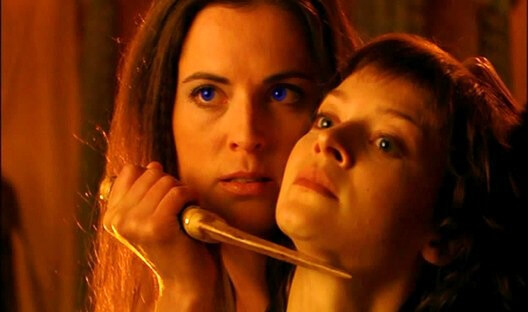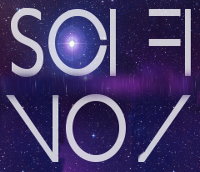I really wanted to pull off a sci-fi fairy tale legacy. How cool would that be to look at a sci-fi story that’s really a fairy tale and explore how it fits into or defies the fairy tale legacy? But I couldn’t find one. Mostly I looked at tv shows because that’s my favorite sci-fi medium, but I also thought through books and movies and I couldn’t find anything.
Which got me thinking – what makes a story a fairy tale? Does it have to be a retelling of one of the classic tales (like Marissa Meyer’s Lunar Chronicles)? Does it have to include fairies (like The Treachery of Beautiful Things which isn’t a retelling but is totally a fairy tale and not sci-fi at all)? Could a sci-fi story attain that element that makes something a fairy tale and not just a fantasy?
J.R.R. Tolkien gave extensive thought to fairy tales in his 1938 Andrew Lang Lecture, On Fairy-Stories. And I have not found a better source that explores the qualities and origins of fairy tales. While he explores the nature of fairies (not diminutive in size, often not what they appear with the power to play on the desires of man’s body and heart) he asserted that fairy-stories were not about the creatures, but the realm of faerie. And faerie is distinguished by magic.
In that sense, sci-fi is something of the antithesis of fairy tales. Because, at least in most sci-fi, magic is reduced to science; the unexplainable contained in explanation. Since a great deal of sci-fi is aboard spaceships, Tolkien would classify those as travelers tales. Valuable in exploring possibility (another component of fairy tale) but lacking in desire.

Except in our modern world, I think, sci-fi stories are full of desire. Science has unveiled to us the wonders and terrors not just of this world but of galaxies. We want to explore and we want to experience technology that can change us, fascinate us, move us up to or beyond the speed of light.
In that sense, sci-fi as a genre is supremely good at another of Tolkien’s elements of fairy-tale, that of Recovery; of seeing our world anew. But there is a catch. Recovery is about renewal, about seeing things “freed from the drab blur of triteness or familiarity – from possessiveness.” I included the bit about possessiveness because Tolkien goes on to say it’s the things that glittered and caught our attention, so we caught them, put them in our dragon hold and ceased to look at them. They would become tarnished from closed in space and lack of use and sci-fi often presents to us a tarnished world. It legitimizes the “fantasy” elements of the story by putting rust on it; by making it familiar; something possessed and therefore “real” and in doing so it becomes, again, the opposite of a fairy tale.

So how could a sci-fi story achieve the elements of a fairy tale enough to explore the fairy tale legacy – the ideas we have about women and princesses and their strengths and weaknesses. Clearly, it has not yet or I would have an entirely different post on my hands. Dune came close, it has princesses and marvelous women but is not really a fairy tale, especially the deeper you go into the series. And I seriously considered the Lunar Chronicles, except that I really wanted a story that was not a retelling. Only because then it’s simply another version of characters I’ve already explored.
I wanted something new; something with science and a complicated world of technology (and possibly princesses of one form or another) with the element that sci-fi seems to predominately lack… wonder.
There are, in fact, many wonderful things in sci-fi. We are awed by nebulas and stars and the beauty of skies not seen through atmosphere. We are fascinated by extraordinary new planets with double moons or only a breath of sunlight every few years. For a moment they may evoke wonder in us.
But the key to a fairy story is the happy ending. Tolkien expresses that tragedy is the true form of drama while the happy ending (or eucatastrophe) is the true form of a fairy story. The eucatastrophe is that sudden, unexpected joyous turn. In the face of sorrow, of failure, of the certainty of defeat there is sudden and miraculous grace – which does not exist in sci-fi because grace cannot be defined or measured. It is “a catch of breath, a beat and lifting of the heart, near to (or indeed accompanied by) tears” that is the true magic of the fairy story.

And sci-fi, predominately though not exclusively, prefers consolation; the not quite happy ending. The characters, battered and bruised get knocked right to the edge of failure, pay a tragic cost and once they’ve satisfied the dramatic are allowed an element of happiness. A satisfaction that is not really what anyone wanted but is not so bad as it could have been.
That is why they are not fairy tales, however fantastical they may be or how many princesses they contain (Starbuck is totally a princess).
And so I could not explore how a story I could not find dealt with our cultural legacy of princesses.
But wouldn’t it be cool? A combination of our love for science and technology – the awesome things we could do some day and the wonder of the eucatastrophe; a story that unfolds on a spaceship and lets us glimpse the wonder of the stars and manages still to be a fairy tale.

*featured graphic from Battlestar Galactica (NBC/Universal)

It’s so amazing when the two can be mixed like that! I also love that one of your sources was Tolkien, my favourite author <3
Tolkien’s totally one of my favorites too!
Maybe Star Wars: A New Hope is closest to a Sci-Fi fairy tale I’ve seen. Force acts as a sort of magic and even allows the happy ending. (But I tend to think of Star Wars as fantasy with SF window dressing, anyway. :))
I actually did think of Star Wars as an option, though I’m planning to include it in a follow up post about sci-fi and mythology. I didn’t think specifically about A New Hope but now I think you’re totally right, it comes the closest. It definitely has those fantasy elements, especially the first three before he tried to explain the force in Episode I (which just sort of ruined it).